|
A monastic orchestra normally consists of twenty people, no matter whether this is a large or a small monastery. When performing the tsam, the musicians get into two lines, one behind the other. The tambourines and drummers are seated in the front row. Behind them, there are seated the wind section setting the tone as well as the cymbalists.
Instruments
- Cymbals = small sound plates (Mongolian: Tsan)
They look like small brass plates, in the middle of which there are put knob-like handgrips.
- Cymbals = large sound plates (Mongolian: also Tsan)
These are plates made from bell metall with knob-like handgrips in the centre.
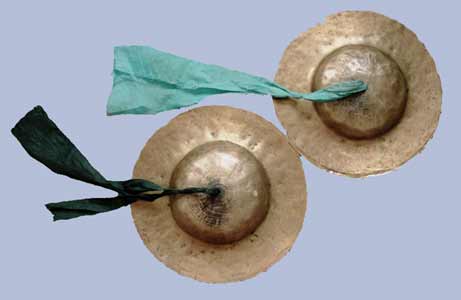
Tsan
- Denshig = sound plates (they are only used in Mongolia)
These are two planished brass plates, the grips (knobs) of which are connected by a small strap. On the occasion of church services a Lama bangs two small plates against one another, thus producing a sound similar to the sound of a little bell, but significantly smoother and more melodic.
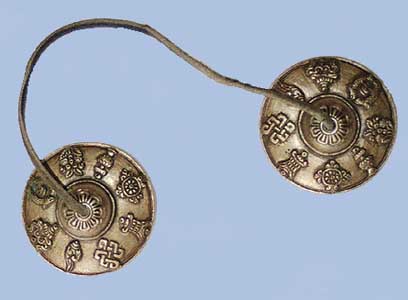 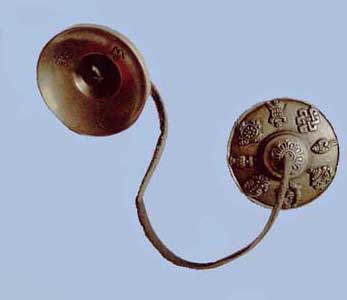
Denshig
- Kettledrums or large drums (Mongolian: Hengereg)
These are the major instruments of the orchestra. Apart from them, there are also smaller drums (Mongolian: Damar) that are tuned differently. They are remarkably broad. The drumsticks are very often bent in a S-form and sometimes have their ends in the form of the head of an elephant-seal or sea elephant.
- Tibetian long horn = trumpet (Mongolian: Ikh buree)
The trumpets made from copper have a length of 2 to 5 metres. They give a bloodcurdling bass note which then swells and dies away.
As the legend has it, his Indian friends gave Padmasambhava these instruments in order to offer him a replacement for the bellowing of the heavenly elephants he could not find an opportunity to listen to in Odijana where he had been invited to.
- Lavai = white shell (Mongolian: Tsagaan buree)
White shells with whorls leading from the left to the right handside are considered a lucky charm, and therefore they are very much in demand. In order to blow them, they are equipped with a mouthpiece made from brass.
According to a Lamaistic legend, Buddha himself gave this instrument to the Dragon King as a present.
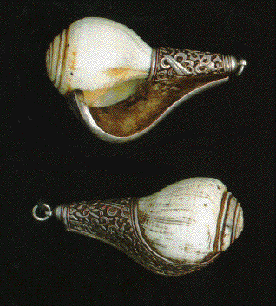
Lavai
Flute made from human bones (Mongolian: Gangling)
It has a similar form like an oboe. Louver and mouthpiece are enclosed with silver or gold.
These flutes are also used as ritual objects. They should be made from femurs of human beings who had very high or low social ranking, who died of an infectious disease, or who were murder victims.
"The most magic effect, however, is said to be associated with a gangling that was manufactured from the left femur of a 16-year-old Indian who had been member of the priest caste."

Gangling
- Trumpet (Mongolian: Bishgüür)
A trumpet made from copper and decorated with rich ornaments.
 |
 |
|
| Bishgüür (Mongolia) |
Metal trumpet (Tibet) |
|
- Gongs
They are also made from copper and give sound by means of drumsticks.
Mask Costumes - Boots
The mask costumes are very colourful and decorated with numerous embroidered ornaments. The costumes of the deity masks are fabricated from expensive cloths, mainly from brocade or atlas silk, whereas the fabrics for the costumes of the other masks are made from wool or cotton.
- Costumes
The design of the masque costumes is rather unique. The sleeves are tapered to produce a tip, and they are cut rather loose in order to keep therein arms and other objects. The large collars (capes) fall loose, reaching beyond the shoulders. Religious symbols are sawn on the costumes in the middle of the broad aprons.
- Cape (Mongolian: Modig)
- Apron (Mongolian: Dodig)
The major masks wear a decorative cape over the whole costume (Ruujin), which consists of about eight pearl strings made from human or animal bones. In Mongolia there can also be found capes made from ivory. The joints are decorated with Buddhist symbols.
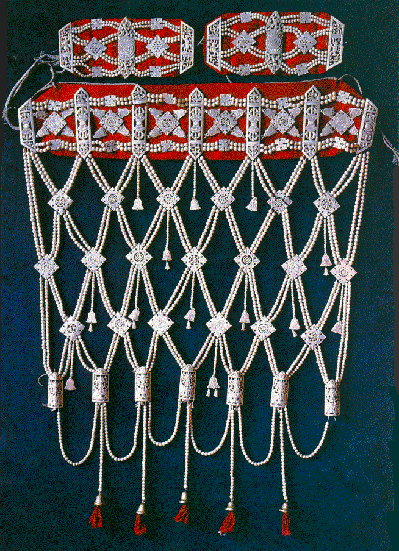 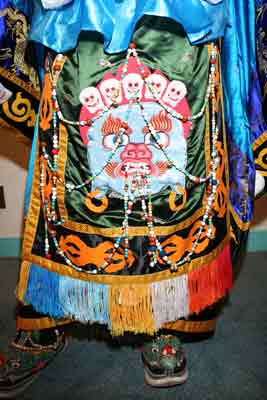
Ruujin
Even the boots are decorated with heads of sea monsters (Makara). These are meant to put off demons, and while dancing, the dancers try to crush their bodies by means of predetermined steps. The sole of the foot is pulled to the front top in order to not damage the soil while kicking and crushing the spirits.
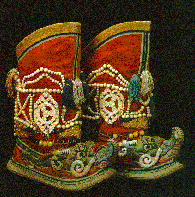 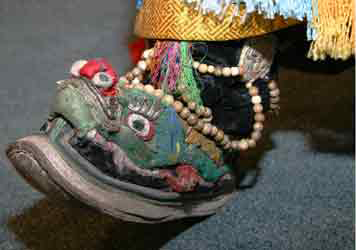
Boots
Masks
The larger-than-life masks of the deities are put over the head, and they cover the whole of the face. The masks representing human beings are only facemasks of natural size.
For the production of these masks, a mass made from papier-mâché (also in Mongolia) as well as a thin and embossed copper sheet are used. In areas with larger wood resources than in the Tibetian uplands, such as in Sikkim and Bhutan, the masks are also carved from hard wood. There the humid climate would quickly destroy the paper mass. The people from Tua, on the other side, fabricate their masks from leather.
- see more about Production of masks
- see more about Dance Masks
The mask is very often combined with a wig made from the hair of yak tails. The masks are usually colourfully painted.
The colouration of mask and costume follows old tradition and is identical with Lamaistic iconography.
Ulaanbaatar, September / October 1999 - Albi
English translation: Hermelinde Steiner
|
